
Food safety and postharvest sanitation practices in citrus packing houses
Food safety and postharvest sanitation practices in citrus packing houses
SP Singh*, John Golding, Roberto Marques | Centre of Excellence for Market Access, NSW DPI, Ourimbah
October 2015
The 'clean, green and safe' image of the Australian citrus industry is well known and a competitive advantage in export markets. However, there is a need to maintain and strengthen this selling point in highly cost-competitive markets. With this in mind, it is important to target consumers who are willing to pay a premium for quality, safety and sustainability. Gaining and retaining access to these markets is critical to ensure the industry's long-term growth.
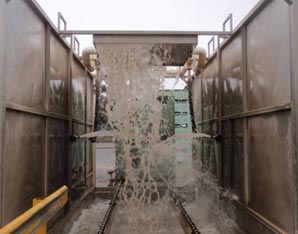
Food safety is the top priority for consumers in both domestic and international markets. Three types of contamination (physical, microbial and chemical ) can occur during production and postharvest handling of fruit.
This article covers the microbial and chemical aspects of contamination, while the next article 'Physical injury testing for citrus fruit' covers some aspects of preventing physical injury.
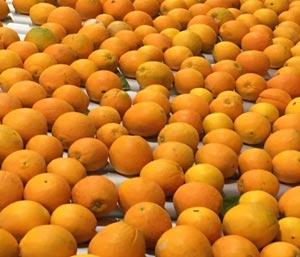
The nature of citrus fruit, having a high acid content and mostly inedible tough skin (used for some products), helps reduce microbial risks.
The chemical risks can be significant in citrus fruit due to the various insecticides and fungicides during production and packing. Consumers, regulators and industry are looking forward to zero-residue on the fruit. However, increasing pest and disease challenges are making it difficult for growers and packers to meet regulatory requirements and consumer expectations.
NSW DPI's Horticultural Market Access Research Team and industry development officers visited six citrus packing houses in the NSW Riverina and Sunraysia regions in July 2015. Another packing house on the Central Coast was later visited in August 2015. The objective was to gain insights into the current postharvest practices and to understand existing and potential technical problems limiting their capability to supply high quality, safe fruit to consumers. Swabs were taken from different locations in the packing line to assess the microbial load and spore count.
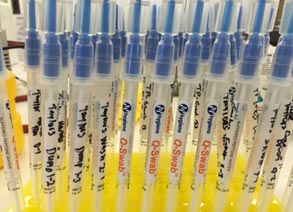
A summary of observations is presented in Table 1. They are generalised to present a snapshot of the industry practices across these citrus producing regions and packing house sizes. However, the packing houses involved in fruit export change their practice, such as choice of sanitiser, fungicide concentration and wax formulation, according to the destination market's regulatory requirement.
Table 1: A summary of observations in the packing houses visited in the Riverina, Sunraysia and Central Coast regions.
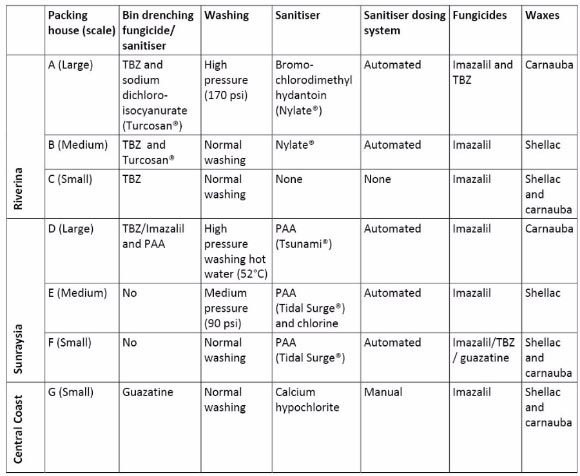
Some key observations were:
- Thiabendazole (TBZ) alone or in combination with a sanitiser (e.g. Turcosan or Tsunami®) was the preferred fungicide to bin drench harvested fruit. One small and one medium-sized packing shed (sheds E and F in Table 1) preferred to process the fruit with a minimum waiting time between harvesting and processing and did not practice bin drenching.
- Large-scale packing houses had high pressure washing systems, which is considered effective in reducing the microbial load and chemical residues on the fruit surface.
- All packing houses except one used at least one sanitiser in the wash water to prevent microbial contamination.
- In the Sunraysia region, all three packing houses used peroxyacetic acid (PAA)-based sanitisers; their efficacy is less affected by pH and organic load.
- Two packing houses in the Riverina used pomo-chlorodimethyl hydantoin (Nylate®).
- Automating sanitiser dosing is quite common, which helps regular monitoring and maintenance of the concentration.
- Packing house G, which used calcium hypochlorite and manual dosing, has wash water with a pH of5.3-5.4 in its favour and could manage sanitiser efficacy without pH adjustment.
- The wash water was changed at least once each day in all packing houses.
- Fungal pathogens (e.g. Penicillium digitatum, P. italicum, Geotrichum citri-aurantii ) cause the fruit to rot (green mould, blue mould and sour rot)resulting in significant postharvest losses during storage, transit and marketing. Industry regularly uses two fungicides, thiabendazole and imazalil, to control postharvest fungal rots. Guazatine fungicide application was observed in one packing house (G) on the Central Coast as it can control all major rots including sour rot.
- Imazalil is the most common postharvest fungicide applied on the packing line. One large packing house in the Sunraysia region used high pressure washing along with a hot fungicide (52 °C) treatment.
- The carnauba wax formulations are popular among large packers that export fruit. They select a wax formulation suitable for each export market's regulatory requirements. Shellac alone, and in combination with carnauba, was a common waxing material in small- to medium-sized packing houses.
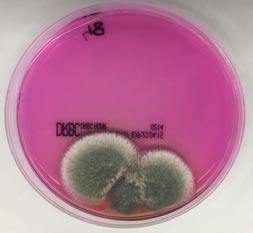
Improvement and future work
- Hygiene and sanitation are important for achieving food safety and minimum decay. Regularly monitoring wash water quality, fungicide and sanitiser concentrations, and spore counts can alert packers to a problem and allow them to take corrective action.
- Because TBZ and imazalil are the predominant fungicides to prevent postharvest fungal disease, it is important to prevent fungicide resistance becoming an issue. It is recommended that swabs are regularly taken and spores tested for resistance. Fungicide treatment can be enhanced by heat, which is still not widely practiced. supplementing fungicides with other generally recognised as safe (GRAS) compounds and heat can improve disease control, which could possibly lower fungicide concentrations.
- Minimise physical injuries to the fruit during harvest and postharvest handling (see next article: 'Physical injury testing for citrus fruit').
- The 'zero-residue' concept means alternative treatments need to be explored to minimise reliance on chemicals for postharvest disease control. NSW DPI's research on plasma application to control fungal rots in citrus will be presented in the next edition of the CitrusConnect.
For more information on this project, email SP Singh or phone 02 4348 1935.

